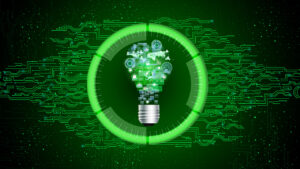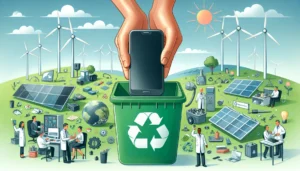Eco-friendly design for products is at an exciting crossroads. As environmental issues grow more pressing and technology is evolving at a rapid speed, designers are changing the way products interact with our world. This change goes beyond just making products “green”—it will be a radical change in the way we think about how we create, use, and consume technology. The integration of sustainability science, modern materials, and digital technology creates products that do more than just reduce the harm but actually aid in the restoration of the environment. Understanding these trends will help designers, businesses, and users navigate the constantly changing environment of sustainable technology.
Consumer Demand
Forces of the market drive radical changes in the design of eco-tech products. People, especially younger ones, tend to be more concerned about environmental impact in their purchases. This has transformed sustainability from an optional feature to a fundamental necessity. Studies show that 73% of world buyers are more willing to pay more for goods made by companies that are committed to reducing environmental impacts. This desire manifests itself in many ways: longer product lifespans, including repairability, transparency of supply chains, as well as carbon-neutral manufacturing processes. Companies that previously viewed sustainability as a benefit to their marketing have now recognized it as an essential requirement to survive.
Material Innovation
Innovative materials are changing eco-tech products from the molecular to the cellular level. Bioplastics made of mushrooms, algae, or recycled ocean plastics are replacing conventional petroleum-based products. These innovations go beyond simple substitution—they’re enabling entirely new product categories. Self-healing materials could extend the life of products dramatically, and biodegradable electronics are promising to eliminate problems with electronic waste. Nanomaterials like graphene offer incredible strength-to-weight ratios that allow for lightweight, more efficient products. The lab-grown synthetic leather, as well as bio-fabricated fabrics, is disrupting conventional manufacturing with superior performance.
Circular Economy
The circular economy is changing the philosophy of design for products. In lieu of the conventional approach of take-make-dispose, designers are now considering the entire lifecycle of a product from its inception. This requires the design of disassembly, material recycling, and multiple usage cycles. The products are now viewed as temporary custodians of valuable material instead of permanent consumer products. Design for circularity affects every aspect of product development, from the selection of components to the designs for user interfaces. Companies are implementing take-back programs, modular designs that allow component upgrades, and products-as-a-service models that maintain manufacturer responsibility throughout the product lifecycle.
Energy Efficiency
Energy efficiency has grown from a simple optimization objective to a complete design philosophy. Modern eco-tech devices don’t only make use of less energy; they actively control energy flow within larger systems. Power management systems that are sophisticated are able to shift energy consumption into the most optimal time, connect with renewable energy sources, and provide energy back into the grid. Machine learning algorithms optimize energy consumption patterns based upon real-world data, creating products that get more efficient with time. The integration of energy harvesting technologies—capturing power from ambient sources like light, vibration, or heat—is creating products that require minimal external energy input.
Smart Tech Integration
AI as well as IoT connectivity are enabling eco-friendly technologies that learn, adapt, and automatically optimize. Intelligent algorithms evaluate patterns of usage and environmental conditions, as well as preferences of users, to improve efficiency and reduce the amount of waste. They can also communicate with other devices, resulting in interconnected systems that maximize utilization of resources across whole structures or communities. Predictive maintenance tools can identify the possibility of failure before it occurs, avoiding the production of waste and prolonging the life of products. Cloud-based intelligence allows devices to benefit from collective learning. The insights of thousands of customers can boost efficiency for all users.
Regulatory Impact
International standards and regulations from the government encourage eco-tech innovations and establishing minimum performance standards. The extended producer accountability laws force manufacturers to take care of the end-of-life cost and encourage repairable, durable designs. Energy efficiency standards are constantly tightening, making technological advancements more challenging and making eco-friendly, high-performance products more efficient. Carbon pricing mechanisms make the actual environmental costs of products apparent in the market price. The Right-to-Repair law is forcing manufacturers to design products for repairability and to provide repair information. International agreements regarding electronic and plastic waste are setting global standards that guide the design of products around the world.
Future Trends
New technologies are set to revolutionize the design of eco-tech products in unimaginable ways. Quantum computing is able to solve complicated optimization issues that make the current gains in efficiency appear small. Biotechnology integration can result in products that develop and grow, blurring the lines between the biological and technological systems. Innovative recycling techniques, such as molecular disassembly and chemical recycling, will make any substance truly circular. Autonomous systems could maximize resource use across whole cities, with products participating in huge coordination networks. Space-based manufacturing may provide production methods that aren’t possible on Earth and could result in products and materials that have little impact on our environment.
Embracing the Eco-Tech Revolution
Future eco-tech design is more than just technological advances. It’s a radical rethinking of humankind’s relationship to the physical world. As the demand for consumer goods fuels innovation, the science of materials allows for new possibilities, and regulations provide guidance, we’re witnessing the development of products that improve human lives while revitalizing natural systems. Companies and designers who take advantage of these developments today will determine the future of sustainable technology. For consumers, knowing about these changes will help them make better choices that are in line with personal preferences and the environment. The change is already happening. The issue is not whether green technology will change product design as it currently exists, but rather how quickly and thoroughly this transformation will occur.
FAQs
1. What distinguishes a product as truly “eco-tech” compared to being merely environmentally sustainable?
Eco-tech products utilize the latest technology to enhance environmental performance. They go beyond mere material substitution to make use of AI, sensors, and connectivity for active green benefits.
2. How will environmental regulations affect eco-tech products’ development timetables?
The typical regulations have two- to five-year timeframes for implementation; however, companies typically have to make design changes as soon as they can in order to meet the requirements of the future, which is why regulatory knowledge is essential to product design.
3. Are eco-friendly products going to cost more than conventional alternatives?
Although the initial cost may be higher for eco-tech products, they typically offer a lower total cost of ownership due to lower energy costs, longer lives, and lower maintenance requirements.
4. What can customers do to discern genuine eco-tech innovations from eco-friendly gimmicks?
Find specific performance indicators, third-party certifications, transparent supply chain information, and products that offer tangible environmental benefits, not simply making statements.




